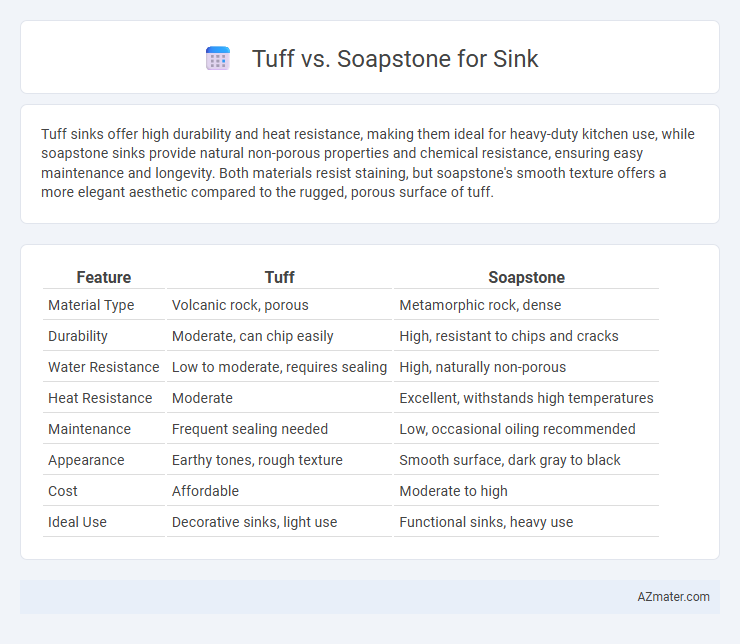Tuff sinks offer high durability and heat resistance, making them ideal for heavy-duty kitchen use, while soapstone sinks provide natural non-porous properties and chemical resistance, ensuring easy maintenance and longevity. Both materials resist staining, but soapstone's smooth texture offers a more elegant aesthetic compared to the rugged, porous surface of tuff.
Table of Comparison
| Feature | Tuff | Soapstone |
|---|---|---|
| Material Type | Volcanic rock, porous | Metamorphic rock, dense |
| Durability | Moderate, can chip easily | High, resistant to chips and cracks |
| Water Resistance | Low to moderate, requires sealing | High, naturally non-porous |
| Heat Resistance | Moderate | Excellent, withstands high temperatures |
| Maintenance | Frequent sealing needed | Low, occasional oiling recommended |
| Appearance | Earthy tones, rough texture | Smooth surface, dark gray to black |
| Cost | Affordable | Moderate to high |
| Ideal Use | Decorative sinks, light use | Functional sinks, heavy use |
Introduction to Tuff and Soapstone Sinks
Tuff sinks are crafted from volcanic tuff, a lightweight and porous natural stone known for its durability and unique texture, making it an increasingly popular choice in kitchen and bathroom design. Soapstone sinks, composed of dense metamorphic rock rich in talc, offer exceptional resistance to heat, stains, and bacteria, providing both functional reliability and a smooth, matte finish. Both materials bring distinct aesthetic appeal and performance characteristics, catering to diverse preferences and practical needs in sink selection.
What is Tuff? Characteristics and Formation
Tuff is a type of igneous rock formed from volcanic ash ejected during explosive volcanic eruptions that later compacts and solidifies. Its porous, lightweight structure provides moderate durability and heat resistance, making it less dense than soapstone but suitable for unique, natural-looking sinks. The mineral composition of tuff, primarily volcanic glass and small fragments, gives it a distinctive texture and color variation not found in the uniformly smooth and denser soapstone.
What is Soapstone? Properties and Origins
Soapstone is a metamorphic rock primarily composed of talc, known for its soft, smooth texture and natural resistance to heat and stains. Originating from regions such as Brazil, India, and the United States, its high talc content gives it a soapy feel and excellent durability for kitchen sinks. Soapstone sinks are prized for their non-porous surface, which resists bacteria and requires minimal maintenance compared to other materials.
Durability Comparison: Tuff vs Soapstone
Tuff, composed of compacted volcanic ash, offers moderate durability with good resistance to heat and stains but is more prone to chipping and scratching compared to Soapstone. Soapstone, a dense metamorphic rock rich in talc, excels in durability due to its natural resistance to heat, acids, and common household chemicals, making it highly scratch-resistant and less likely to chip. When comparing durability for sinks, Soapstone outperforms Tuff by maintaining structural integrity and aesthetic appeal under heavy use and exposure to moisture.
Maintenance Requirements for Tuff and Soapstone Sinks
Tuff sinks require minimal maintenance due to their durable, non-porous surface that resists stains and bacteria buildup, needing only regular wiping with mild soap and water to maintain their appearance. Soapstone sinks demand more attentive care as they are softer and more porous, requiring periodic oiling with mineral oil to prevent staining and maintain their natural finish. Both materials benefit from prompt cleaning of acidic substances to avoid surface etching, but Tuff's hardness makes it more resilient in high-traffic kitchen environments.
Aesthetic Appeal: Visual Differences
Tuff sinks exhibit a rugged, volcanic stone texture with earthy tones that bring a natural, organic aesthetic to the kitchen. Soapstone sinks offer a smooth, matte finish with soft veining and tonal variations, enhancing a sophisticated and timeless look. The visual difference lies in Tuff's coarse, tactile surface compared to Soapstone's polished, elegant appearance, catering to contrasting design preferences.
Cost Analysis: Tuff vs Soapstone Sinks
Tuff sinks generally offer a more budget-friendly option compared to soapstone sinks, with costs typically ranging from $150 to $400, depending on size and design complexity. Soapstone sinks, known for their durability and natural aesthetic, can cost significantly more, often between $800 and $1,500, reflecting the higher material and fabrication expenses. The initial investment in soapstone may be justified by its resistance to heat, stains, and bacteria, potentially reducing long-term maintenance and replacement costs.
Installation Process and Challenges
Tuff sinks typically require specialized drilling equipment due to their hardness, making installation more complex and time-consuming compared to soapstone. Soapstone sinks offer easier cutting and shaping, allowing for more straightforward customization and fitting during installation. Challenges with tuff include the risk of cracking if not handled properly, while soapstone demands careful sealing to prevent stains and maintain durability.
Environmental Impact and Sustainability
Tuff, a natural volcanic rock, boasts low environmental impact due to minimal quarrying disruption and its high durability, reducing the need for frequent replacements. Soapstone is sustainably sourced with its non-porous surface eliminating the need for toxic sealants, further enhancing eco-friendliness. Both materials offer exceptional longevity, but tuff's energy-efficient extraction process gives it a slight edge in overall sustainability for sink applications.
Which Sink Material is Best for You?
Tuff sinks offer exceptional durability and resistance to scratches and heat, making them ideal for busy kitchens that require low-maintenance surfaces. Soapstone sinks provide a natural, smooth finish with excellent resistance to stains and bacteria, favored for their classic aesthetic and ease of repair through simple sanding. Choosing the best sink material depends on your lifestyle needs: select Tuff for heavy-duty use and long-lasting toughness or opt for Soapstone if you prefer a warm, natural look with easy maintenance.

Infographic: Tuff vs Soapstone for Sink
 azmater.com
azmater.com